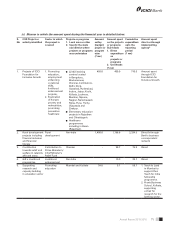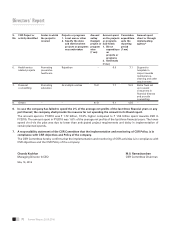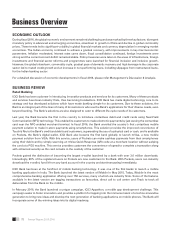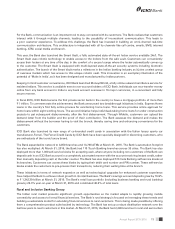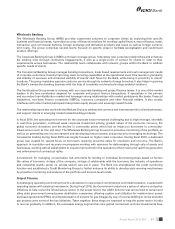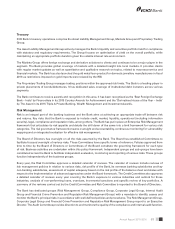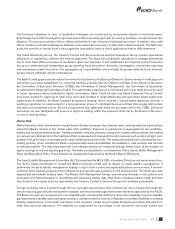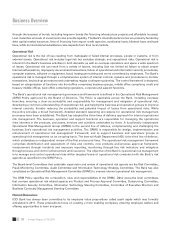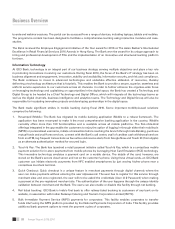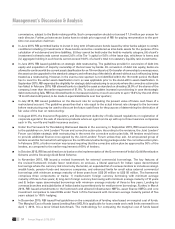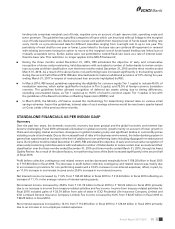ICICI Bank 2016 Annual Report Download - page 87
Download and view the complete annual report
Please find page 87 of the 2016 ICICI Bank annual report below. You can navigate through the pages in the report by either clicking on the pages listed below, or by using the keyword search tool below to find specific information within the annual report.
85Annual Report 2015-2016
The technical valuations in case of residential mortgages are conducted by empanelled valuers or technical teams.
External agencies (eld investigation agencies and credit processing agencies) are used to facilitate a comprehensive due
diligence. The process includes visits to ofces and homes in case of loans to individual borrowers. In addition, the credit
ofcer checks a centralised delinquent database and reviews the borrower’s prole before disbursements. The Bank also
avails the services of certain fraud-control agencies operating in India to check applications before disbursements.
The Credit Monitoring Group, the Treasury Control and Services Group and the Operations Group monitor operational
adherence to regulations, policies and internal approvals. The Bank has centralised operations to manage operational
risk in most back ofce processes of the Bank’s retail loan business. It has established the Financial Crime Prevention
Group as a dedicated and independent group, handling fraud prevention, detection, investigation, monitoring, reporting
and awareness creation functions. The segregation of responsibilities and oversight by groups external to the business
groups ensure adequate checks and balances.
The Bank’s credit approval authorisation framework is laid down by the Board of Directors. Several levels of credit approval
authorities have been established for corporate banking activities like the Credit Committee of the Board of Directors,
the Committee of Executive Directors (COED), the Committee of Senior Management, the Committee of Executives
(Credit) and the Regional Committee (Credit). The authorisation framework is risk based with lower rated borrowers and/
or larger exposures being escalated to higher committees. Retail Credit Forums and Small Enterprise Group Forums
have been created for approval of retail loans and credit facilities to small enterprises and agriculture based enterprises
respectively. In addition, the Bank conducts programme lending, which involves a cluster-based approach, wherein a
lending programme is implemented for a homogeneous group of individuals/business entities that comply with certain
laid down parameterised norms. All such programmes and applicable limits are pre-approved by the COED. Individual
executives are also delegated with powers to approve lending within the exposure limits set by the Board of Directors,
in case of retail products.
Market Risk
Market risk arises when movements in market factors (foreign exchange rates, interest rates, credit spreads and equity prices)
impact the Bank’s income or the market value of its portfolios. Exposure to market risk is segregated into two portfolios-
trading and structural banking books. Trading portfolios comprise positions arising from market making activity and trading
on own account. Market risk on the trading portfolio is assessed and managed through measures such as net overnight open
position limit, price value of one basis point, value-at-risk and stop loss limits. The structural banking book comprises the non-
trading portfolio, which includes the Bank’s corporate/retail assets and liabilities, the available for sale portfolio and the held
to maturity portfolio. The risks associated with non-trading portfolios are measured through metrics such as the duration of
equity, earnings at risk and liquidity gap limits. The limits are stipulated in our Investment Policy, Asset Liability Management
Policy and Derivatives Policy. These policies are reviewed and approved by the Bank’s Board of Directors.
The Asset Liability Management Committee (ALCO) comprises the MD & CEO, wholetime Directors and senior executives.
The ALCO meets periodically to review the Bank’s business prole and its impact on asset liability management. It
determines the asset liability management strategy in light of the current and expected business environment. It reviews
positions of the trading groups and the interest rate and liquidity gap positions on the banking book. The ALCO also sets
deposit and benchmark lending rates. The Market Risk Management Group recommends changes in risk policies and
processes and methodologies for quantifying and assessing market risks. Risk limits including position limits and stop
loss limits for the trading book are reported by the Treasury Control & Services Group and reviewed periodically.
Foreign exchange risk is tracked through the net overnight open position limit. Interest rate risk is measured through the
use of re-pricing gap analysis and duration analysis; and is tracked through interest rate risk limits approved by the ALCO.
The Bank uses various measurement tools of liquidity risk, including the statement of structural liquidity, dynamic liquidity
gap statements, liquidity ratios and stress testing. It maintains diverse sources of liquidity to facilitate exibility in meeting
funding requirements. Incremental operations in the domestic market are principally funded by accepting deposits from
retail and corporate depositors. The deposits are augmented by borrowings in the short-term inter-bank market and


